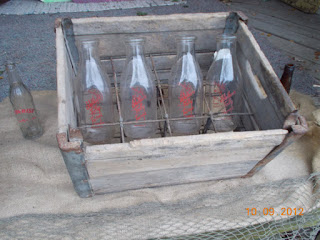Originally published January 5, 2000

As we travel about the country, and even at home, we like to stop at yard sales to browse. I look for books. Some I read a long time ago and some I never read but always wanted to own. I look for authors such as
Roark Bradford and
Edgar Greene [
Editor's note: more commonly known as "Doc Greene," he was a popular columnist for the "Detroit News," and one of Jim's favorite authors. They shared a sporadic correspondence over the years and when Doc died in 1970, Jim attended his funeral. I think Doc was Jim's mentor and the role model for his own columns.] When I find one, I add the book to my collection. Many times I find items for sale that have no meaning to me, except that they were commonplace when I was young. In the few short years since my youth, they have become collector's items and antiques.
Among these yard sale lots are articles from the dairy industry where I spent my early working years, and among the most common collectibles are old milk bottles. They came in many shapes and sizes. Some had inscriptions of various colors and styles. Early bottles were round with a large mouth for pouring. Before homogenization became common, many bottles were shaped like a woman wearing a hoop skirt and sporting a bulging bust line. The bust line was a place for the cream to gather at the top, making it easier to pour off for use as a coffee creamer and in cooking. Or, to feed the cat.
Some milk bottles were scripted in beautiful gothic or Germanic lettering. In Detroit, one creamery used an Olde English style of lettering, such as you still see on the "D" sewn onto Detroit Tigers baseball caps.
Of course, I'm talking about the glass bottles that were used to package all milk products. These days, rarely is glass used to transport liquid products of any kind. Paper and plastic have replaced glass. The old type of round milk bottle I worked with years ago now sells for up to $5.00 at yard sales and much more at some auctions.
Other milk products seen in yard sales these days include milk cans. These cans came in three, five, and ten gallon sizes. They were made of aluminum or stainless steel. A full 10 gallon can contains 80 pounds of milk. Add the weight of the can, and it's close to 90 pounds. No wonder wrestling those things about used to tire me out. After I had moved a half dozen or so, the three gallon size seemed to leap off the floor when I moved them.
In the 70s and 80s, people painted designs on those outdated cans and used them as porch decorations. They usually had floral or plant arrangements sprouting out of the top. The large, decorated milk cans sold for $10 to $15. Now, they're passed down through families as heirlooms and keepsakes.
In the days before refrigeration and tank trucks, the can was the way milk was moved from farms to processing plants. It was labor intensive and a new way to transport milk was developed in the 50s. Rural electricity enabled dairy farmers to reinvent the whole operation. Except for the cow. And even in her case, some serious innovations were made.
Another item I occasionally see at yard sales and, more often, in the garages of private homes, is the milk crate or case. In my day, these cases were all made of wood. And no light weight wood, either. These things were heavy. After a few trips through the cleaning process, wooden crates became water-soaked and even heavier.
Milk cases became so strong that many were stolen by shady mechanics and used as "jacks" to hold up a car while the mechanic worked underneath. They were also used in shops and plants as seats for workers. They were built so well they lasted for years.
When the square milk carton came along, the old milk case became obsolete and a new one had to be developed. This led to a lighter weight, but less strong, case made of plastic saving trees for other uses like newsprint. The new paper milk container made the milk case less complicated, allowing for the removal of the wire sections that had been necessary to corral the glass bottles. These modifications may have resulted in injuries, or even killed some red-necked mechanics fixing cars before they found out the case was too weak for their needs.
Another item I see from time to time at yard sales is the plug cap that sealed freshly filled milk bottles. This wafer-thin gasket-like sealer was absolutely air and moisture proof as long as it was dry. If it got wet, it didn't seal out anything. As a dairy worker, my favorite use of the plug cap was an aggravation weapon. I soon learned to fit them between my thumb and forefinger, like a marble shooter fits his shooting
taw. From 25 feet, I could raise a welt on the back of a co-worker's neck with a well-aimed shot. My modus operandi was to fire and quickly pretend to be working when the wounded target turned around in anger to confront his attacker.
Like me, a lot of the things from my youth are out of date. "Collectibles," they're called. They served their purpose and made it possible for us to reach the point where we are now.







